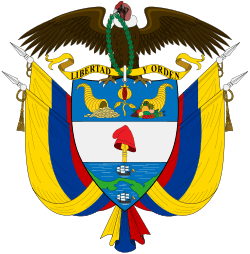List of political parties in Colombia
 |
| This article is part of a series on the politics and government of Colombia |
|
Constitution |
|
Legislature |
|
Executive |
|
Related topics |
This article lists political parties in Colombia.
Colombia had historically maintained a two-party system, which means that there were two dominant political parties, resulting in considerable difficulty for anybody to achieve major electoral success under the banner of any other party. Dissidents from the two main parties also had chances to win elections. Nowadays it is a multi-party system with four main parties.
The parties
Major parties
| Name | Ideology | House 2010 | Senate 2010 | House 2014 | Senate 2014 | ||
|---|---|---|---|---|---|---|---|
| Social Party of National Unity Partido Social de Unidad Nacional |
U | Liberal conservatism | 48 | 28 | 37 | 21 | |
| Colombian Conservative Party Partido Conservador Colombiano |
C | Conservatism | 37 | 22 | 27 | 18 | |
| Colombian Liberal Party Partido Liberal Colombiano |
L | Social democracy, Social Liberalism | 35 | 17 | 39 | 17 | |
| Democratic Center (Colombia) Centro Democrático |
CD | Uribism, Conservatism | 0 | 0 | 19 | 20 | |
Other Parties
| Name | Ideology | House 2010 | Senate 2010 | House 2014 | Senate 2014 | ||
|---|---|---|---|---|---|---|---|
| Radical Change Party Cambio Radical |
CR | Conservative liberalism, Centrism | 15 | 8 | 16 | 9 | |
| Citizen Option Party Partido Opción Ciudadana |
OC | Neoliberalism | 12 (*) | 9 (*) | 6 | 5 | |
| Colombian Green Party Partido Verde Colombiano |
V | Centrism, Green Politics | 3 | 5 | 6 | 5 | |
| Alternative Democratic Pole Polo Democrático Alternativo |
PDA | Democratic socialism | 4 | 8 | 3 | 5 | |
| Mira Movement Independent Movement of Absolute Renovation |
MIRA | Christian democracy | 1 | 3 | 3 | 0 | |
(*) Citizen Option Party is the union of four previous small right-wing parties:
- Democratic Colombia Party (Partido Colombia Democrática)
- Living Colombia Movement (Movimiento Colombia Viva)
- Citizen's Convergence Party (Partido Convergencia Ciudadana)
- Liberal Opening Movement (Movimiento Apertura Liberal)
Minor parties
Indigenous Parties
- Indigenous Social Alliance (Alianza Social Indígena) (Center)
- Indigenous Authorities of Colombia (Autoridades Indígenas de Colombia) (Far-left)
Afro-Colombian communities Parties
- United Popular Movement (Movimiento Popular Unido) (Center-right)
- PROVIDES Association (Asociación PROVIDES) (Center-left)
The constitution of 1991, in order to increase the participation of more people in politics, promoted the end of bipartisan making easy to create new political parties. However, this became counter-productive as many traditional politicians left traditional parties to form their own movements who had very few representation and not clear ideologies. Also, paramilitary groups developed many regional political parties in order to penetrate the State. In 1999, nearly 200 parties had representation in congress, most of them with only one or two congressmen.
Under the Political Reform of 1994, any party that does not get at least 2% of the vote to the Senate or of the electoral quotient to its circumscription to the House of Representatives, is legally dead. This is to promote neater debates and ideologically clear positions in the Congress. In 1994, the number of parties went down from nearly 200 to 106, and in 2004 only 18 parties are legally recognized.
.svg.png)